Phone:
(701)814-6992
Physical address:
6296 Donnelly Plaza
Ratkeville, Bahamas.
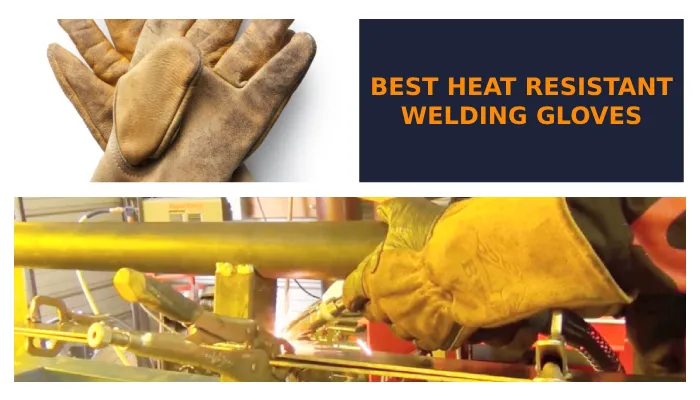
In the world of welding, the adage ‘safety first’ rings true. Choosing the best heat-resistant welding gloves is paramount when protecting your hands from burning.
A welding glove should be able to handle the extreme temperatures generated during the welding process. It should also be able to handle different welding processes, including TIG, MIG, and stick welding.
You should also look into the different material options available, such as leather or Kevlar, to find the one that suits your needs perfectly.
Here, we look at the world of heat resistant welding gloves. We will discuss the importance of checking heat resistance and the specific options available for different welding processes.
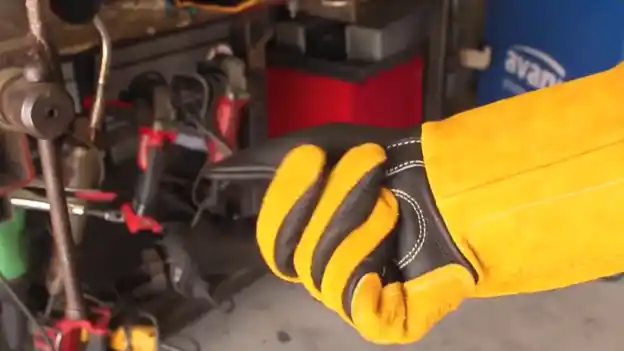
Welding is a high-temperature process that requires specialized gloves to ensure your hands remain unharmed. These gloves are not your average pair, they are designed to withstand intense heat and provide maximum protection. Here are some things to consider when choosing heat resistant welding gloves:
To find the best heat resistant welding gloves for you, consider which welding process you’ll be using. Different welding processes generate varying levels of heat, and it’s crucial to choose gloves that can withstand the specific heat produced by your chosen method.
For instance, if you’re performing MIG welding, which is known for generating intense heat, you’ll need gloves with a higher heat resistance rating to ensure optimal protection.
On the other hand, if you’re engaged in TIG welding, which typically generates lower heat levels, gloves with slightly lower heat resistance may suffice.
Understanding the compatibility between the welding process and the gloves’ heat resistance is essential for selecting the right pair that can effectively shield your hands from heat-related hazards.
Consider the various materials available for welding gloves to ensure you find the perfect fit for your needs. Regarding heat-resistant options, three main materials stand out: leather, Kevlar, and aluminized fabric.
Leather gloves are a popular choice due to their durability and heat resistance. They provide excellent protection against sparks, molten metal, and high temperatures.
On the other hand, Kevlar gloves offer superior cut and puncture resistance, making them suitable for heavy-duty welding tasks. They’re lightweight and provide excellent dexterity, allowing for precise movements.
Lastly, aluminized fabric gloves have a reflective coating that provides excellent heat resistance. They’re ideal for working in high-heat environments, as they reflect radiant heat away from the hands.
Consider the specific requirements of your welding process to determine the most suitable material for your welding gloves. When materials are important, here are some details:
Ensure that your hands are protected like an impenetrable fortress with Kevlar and carbon fiber combination in your welding gloves. These two materials work together to provide exceptional heat resistance and durability.
Kevlar, a synthetic fiber known for its high tensile strength, acts as a barrier against heat, flames, and cuts. It’s also lightweight, allowing for increased dexterity and flexibility.
On the other hand, it adds an extra layer of protection by providing excellent resistance to heat and chemicals. It’s highly resistant to abrasion and has a high strength-to-weight ratio.
The combination of these two materials creates a glove that not only offers superior heat resistance but also ensures maximum comfort and longevity.
Regarding heat-resistant welding gloves, leather is a top choice due to its exceptional durability and ability to withstand high temperatures. Leather gloves are made from animal hides that have been tanned and treated to enhance their heat resistance.
Here are three reasons why leather gloves are the preferred choice for heat resistance:
Understanding the types of leather used in welding gloves can make a big difference in staying protected during different welding processes. Not all leathers are created equal; certain types offer more durability and heat resistance than others.
Here are three types of leather commonly used in welding gloves:
1. Cowhide Leather: This type of leather is known for its durability and heat resistance. It offers excellent protection against sparks and spatter, making it a popular choice for welding gloves.
2. Pigskin Leather: Pigskin leather is another good option for welding gloves. It’s softer and more flexible than cowhide leather, providing a comfortable fit. Additionally, pigskin leather is highly heat resistant and offers good dexterity, allowing welders to handle their tools with ease.
3. Goatskin Leather: Goatskin leather is known for its superior abrasion resistance and flexibility. It offers excellent dexterity and grip, making it a preferred choice for TIG welding. Goatskin leather also provides good protection against heat and sparks.
Choosing the right type of leather for your welding gloves is essential to ensure maximum protection and comfort during the welding process.
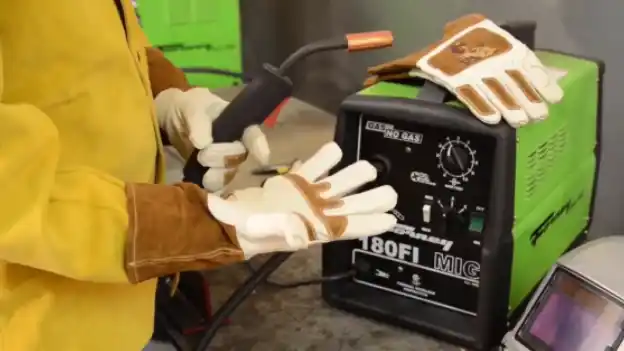
Leather, Kevlar, and aluminized fabric offer different levels of protection against high temperatures in welding gloves. Regarding heat resistance, leather gloves are the most commonly used option. They provide excellent protection against sparks, moderate heat, and abrasion.
On the other hand, Kevlar gloves offer a higher level of heat resistance than leather gloves. They’re designed to withstand extreme temperatures and provide enhanced protection against cuts and punctures.
Aluminized fabric gloves take heat resistance to another level. These gloves are coated with aluminum on the outer layer, which reflects heat away from the hands. They’re ideal for handling hot objects and working in environments with intense heat exposure.
Good welding gloves feature heat-resistant stitching made of materials like Kevlar, which is a durable and robust material that can withstand high temperatures.
Additionally, the stitching should be strong and durable enough to prevent tearing or ripping during use. This is important, as weak stitching can allow heat to penetrate the gloves, resulting in burns or injuries to the hands.
Insulation is another essential factor to consider when choosing welding gloves. Choosing gloves with adequate insulation to protect against high temperatures is crucial, especially during extended use.
Materials like cotton, wool, or fleece provide excellent insulation, as they help absorb sweat and keep the hands dry while providing additional heat resistance.
Moreover, padding and lining materials like wool or cotton-foam can enhance the heat resistance of welding gloves by providing extra cushioning and protection to the hands. Gloves made with these materials provide additional insulation, making them more comfortable to wear for extended periods.
Ensuring that your gloves have the right size and fit is essential for optimal performance and protection during welding operations.
Ill-fitting gloves can restrict your movement, making it difficult to handle tools and perform intricate tasks. On the other hand, gloves that are too loose can create a safety hazard as they may slip off or allow heat to penetrate.
To find the right size, measure the circumference of your hand at its widest point and consult the manufacturer’s sizing chart. Pay attention to the finger length as well, ensuring that it allows for proper dexterity.
Remember, a secure and comfortable fit is key to maintaining control and safety while working with heat.
Welding gloves offer a surprising benefit as they provide a maximum hold time of up to 15 seconds, allowing welders to work precisely and accurately. This is due to the natural heat resistance and insulation properties of the material.
During welding operations, it is crucial to maintain a steady grip on the tools and materials to ensure safety and effectiveness. The table below provides a comparison of the maximum hold times for different types of heat-resistant welding gloves:
| Glove Material | Maximum Hold Time (Seconds) |
| Leather | 15 |
| Kevlar | 10 |
| Aluminized | 8 |
| Carbon Fiber | 5 |
| Synthetic | 3 |
To determine the effectiveness of the gloves, you can test their ability to withstand high temperatures. Start by checking the heat resistance rating provided by the manufacturer. This rating indicates the maximum temperature the gloves can handle without compromising their protective qualities.
One method to verify heat resistance is the flame test. Hold a small flame to the glove’s surface for a short period of time, observing any signs of damage or melting.
Another option is the hot object test. Hold a heated object, such as a metal rod, with the gloves for a set duration, checking for any heat transfer to your hand.
Additionally, you can measure the gloves’ insulation properties by using a temperature probe to monitor the heat transfer.
The table below provides a comparison of some popular heat-resistant welding gloves available on the market:
| Brand | Material | Heat Resistance | Dexterity |
| Glove A | Leather | Up to 900°F | Excellent |
| Glove B | Kevlar | Up to 800°F | Good |
| Glove C | Aluminized | Up to 1000°F | Fair |
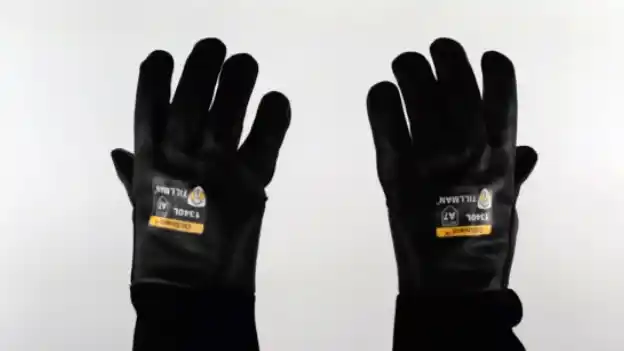
You’ll be amazed at how effortlessly you’ll be able to handle your tools with the incredible length, flexibility, and dexterity of these gloves.
In welding, having gloves that provide adequate length is crucial for protecting your arms from heat and sparks. The longer the gloves, the more coverage you have, minimizing the risk of burns.
Additionally, flexibility is essential for maintaining a firm grip on your tools and materials. These gloves are designed with a high level of flexibility, allowing you to maneuver with precision.
Dexterity is another critical factor, as it determines how well you can manipulate small objects and perform intricate tasks. With these gloves, you’ll experience exceptional dexterity, enabling you to weld with accuracy and ease.
Regarding heat-resistant stitching, a few options are widely recognized for their durability and ability to withstand high temperatures. One popular choice is Kevlar stitching.
Kevlar is a synthetic fiber known for its exceptional strength and heat resistance. It’s often used in industries that require protection against heat and flames.
Another option is Nomex stitching. Nomex is a flame-resistant material that offers excellent resistance to heat and chemicals. It’s commonly used in firefighting gear and other high-temperature applications.
Additionally, some gloves are stitched with heat-resistant leather. Leather is naturally heat-resistant and can provide added durability to the gloves.
For welding jobs that require a firm grip, it is important to consider gloves with a secure grip material such as silicone, non-slip leather, or rubber to provide a good grip on the welding material, tools, and equipment.
At the same time, welders often require a high degree of tactile sensitivity to ensure precision and accuracy in their work.
Thus, choosing gloves with low-profile seams near the fingertips or gloves made from thinner materials, like sheepskin or goatskin leather, can provide the necessary tactile dexterity for expert welding.
It should be noted that gloves with excessive padding or material can interfere with touch sensitivity and dexterity, making it harder to perform welds or handle small equipment. Welders need to find the right balance between heat-resistance and tactile sensitivity.
Manufacturers like Miller, LinedCrown, and Ironclad are some examples of brands that use advanced ergonomic designs to provide maximum tactile sensitivity, comfort, and control.
The cost depends on a variety of factors, including the materials used, the level of heat resistance, the size and the brand. Ultimately, the best heat-resistant welding gloves are those that provide maximum protection while allowing maximum flexibility and dexterity for the user.
Some people may opt for very cheap welding gloves in an attempt to save money. However, it is important to keep in mind that in most cases, these gloves are not heat-resistant. They may even melt or catch fire when exposed to high temperatures, thus increasing the risk of injury.
Choosing a low-quality glove can also mean replacing them more frequently due to wear and tear, which can end up costing more in the long run.
On the other hand, some may be willing to invest a significant amount of money in high-end gloves. While these options may offer additional features like padding or reinforced stitching, weighing the benefits against the cost is important.
Consider the frequency of use, the level of heat exposure and other factors before investing in higher-end gloves.
To find the right gloves for your specific welding processes, you need to consider the different types of gloves available. There are specific gloves designed for different welding processes, each offering unique features to ensure maximum protection.
Here are two sub-lists to help you understand the different gloves available:
1. MIG/TIG Welding Gloves:
2. Stick Welding Gloves:
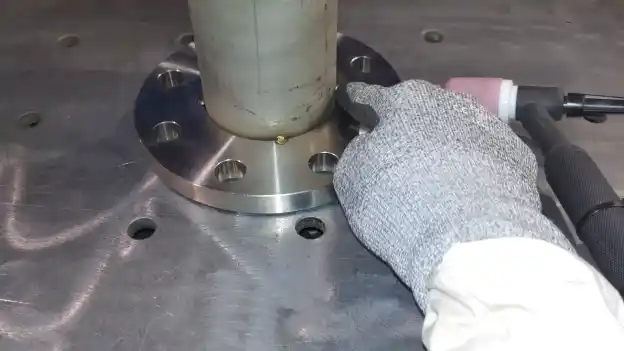
If you’re in the market for gloves specifically designed for TIG welding, you’ll be thrilled to discover these popular options.
One of the top choices is the Lincoln Electric Traditional MIG/Stick Welding Gloves. These gloves are made from durable and heat-resistant cowhide leather, providing excellent protection while still allowing for dexterity and flexibility.
Another popular option is the Tillman TrueFit TIG Welding Gloves. These gloves are constructed with top-grain goatskin leather, which offers high heat resistance and a superior feel. They also have a seamless index finger design, allowing for precise control during TIG welding.
The Caiman 1878-5 TIG/MIG Welding Gloves are an excellent choice for those looking for a more budget-friendly option. These gloves feature a pig grain leather palm for enhanced heat resistance and a comfortable fit.
One of the most popular options for MIG and Stick welding are the Revco Black Stallion 750 Premium Cowhide Welding Gloves. These gloves have a high customer satisfaction rating of 4.5 out of 5 stars. They offer superior heat resistance and durability, making them ideal for heavy-duty welding tasks.
The gloves are made from premium cowhide leather, which provides excellent protection against sparks, heat, and abrasions. They feature a reinforced palm and thumb for added strength and longevity. This ensures that the gloves can withstand the rigors of MIG and Stick welding without wearing out quickly.
Additionally, the gloves have a seamless index finger for enhanced dexterity and control. This allows welders to handle small components with ease.
While both types of gloves offer heat resistance, they differ in terms of construction and materials used. TIG welding gloves are designed to protect against light rather than sparks, which is why they are thinner and made with softer materials.
On the other hand, MIG welding gloves provide outstanding protection for the entire hand against sparks and heat.
For protecting your hands from intense temperatures, TIG welding gloves have got your back. They have an impressive ability to withstand scorching heat and keep you safe. These gloves are specifically designed for TIG welding, which requires precise control and dexterity.
Here’s what you need to know about the temperature rating of TIG welding gloves:
Welding gloves can indeed work as oven mitts. Due to their construction from heat-resistant leather, welding gloves provide excellent protection against high temperatures, making them suitable for handling hot objects such as pizza stones and trays in wood-fire pizza ovens.
Unlike regular oven mitts, welding gloves offer superior heat resistance, allowing you to easily and comfortably navigate the scorching 800-degree oven. Their durable and flexible design enables a secure grip, ensuring that you can handle hot items safely without the risk of burns.
Selecting the best heat resistant welding gloves requires careful consideration of various factors, such as heat resistance, material options, stitching, insulation, and fit.
Leather gloves are ideal for protection against sparks and molten metal, while Kevlar gloves provide excellent cut and puncture resistance, lightweight design, and excellent dexterity. Aluminized fabric gloves are best suited for high-heat environments.
It’s important to note that TIG and MIG welding require specific gloves, tailored for each process. Checking the heat resistance is crucial for safety and protection during welding, and these gloves can also double as oven mitts, adding to their versatility.
By following these guidelines and exploring your options, you can easily find the ultimate heat resistant welding gloves that will provide unbeatable protection and comfort during your welding endeavors.